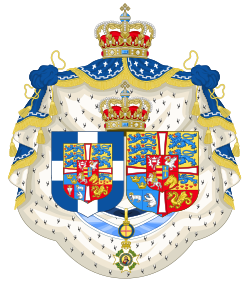| Picture | Coat of arms | Name | Greek name | Father | Birth | Marriage | Became consort | Ceased to be consort | Death | Spouse |
|---|
 |  | Olga of Russia | Ólga | Grand Duke Konstantin Nikolayevich of Russia
(Romanov) | 3 September 1851 | 27 October 1867 | 18 March 1913
husband's assassination | 18 June 1926 | George I |
 |  | Sophia of Prussia
(first tenure) | Sofía | Frederick III, German Emperor
(Hohenzollern) | 14 June 1870 | 27 October 1889 | 18 March 1913
husband's accession | 11 June 1917
husband's abdication | 13 January 1932 | Constantine I |
 |  | Aspasía Mánou
(morganatic wife, created a Princess during widowhood) [2] | Aspasía | Pétros Mános
(Mános) | 4 September 1896 | 4 November 1919 | 25 October 1920
husband's death | 7 August 1972 | Alexander |
 |  | Sophia of Prussia
(second tenure) | Sofía | Frederick III, German Emperor
(Hohenzollern) | 14 June 1870 | 27 October 1889 | 19 December 1920
husband's reinstatement | 27 September 1922
husband's abdication | 13 January 1932 | Constantine I |
 |  | Elizabeth of Romania | Elisávet | Ferdinand of Romania
(Hohenzollern-Sigmaringen) | 12 October 1894 | 27 February 1921 | 27 September 1922
husband's accession | 25 March 1924
husband's exile | 14 November/15 November 1956 | George II |
 |  | Frederica of Hanover | Freideríki | Ernest Augustus III, Duke of Brunswick
(Hanover) | 18 April 1917 | 9 January 1938 | 1 April 1947
husband's accession | 6 March 1964
husband's death | 6 February 1981 | Paul |
 |  | Anne-Marie of Denmark | Ánna-María | Frederik IX of Denmark
(Glücksburg) | 30 August 1946 | 18 September 1964 | 1 June 1973
monarchy abolished | living | Constantine II |
|













